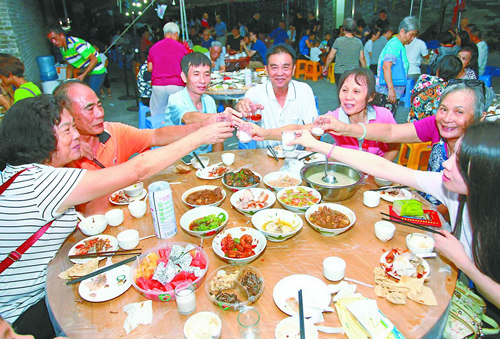Devotees honor deified Tan Yu in Shanchang

A Chenghuangshen temple dedicated to Zhuhai's first city god, Tan Yu, attracted numerous locals and adherents from Zhongshan, Macao, and Hong Kong on Sept 14 to commemorate the man's birthdate, which falls on the 24th day of the 7th lunar month.
Located in New Xiangzhou, Shanchang Village was the earliest political and economic center of Xiangshan County, which comprised today's Zhongshan, Zhuhai, and Macao. At that time, senior official Tan Yu was praised for upholding justice and fair governance. After passing, he was ennobled as the local city god by those wishing for peace and safety.
The most important traditions at the temple appealed to both villagers and those with ties of consanguinity. Descendants of Xiangshan County residents first burned joss sticks at the altar in tribute to the city god who had blessed their ancestors. Many of those families had moved away, some settling in Macao and Hong Kong.
Afterward, each worshiper was served a vegetarian lunch for free with dishes unique to the village. The evening feast, on the other hand, was no-pay for only villagers over age 60.

Banquet celebrates city god's birthdate [Photo courtesy Zhujiang Evening Post]
One of the first Chenghuangshen (god of the moat and walls) temples in China was dedicated to Pak Tai, one of the gods of the sea. It was built in the late Tang Dynasty (618-907) and has more than 2,000 years of history. For all those centuries, Pak Tai has been honored yearly on Zhuhai's Wailingding Island. Miaowan Island, also in Zhuhai, once had its own Pak Tai Temple.
By the Qing Dynasty (1644-1912), it was common for not only gods but also worthy local officials, such as Tan Yu, to be named city gods after their deaths. Such deified leaders continued to serve the deceased from their domain and to interact with the living.
The legacy has been listed as a key cultural heritage under city government protection in order to pass on the customs and hold onto the past, proclaimed an official.
MOST POPULAR
- 1 China to give visa-free treatment to another 9 countries
- 2 China fully opens manufacturing sector to foreign investors in landmark opening up move
- 3 China's import expo attracts record-breaking participating countries, exhibitors
- 4 China's door opening even wider to foreign visitors, businesses
- 5 China revises rules to ease foreign strategic investment in listed firms
Editors' Picks
 Video:
Peru sees new port open
Video:
Peru sees new port open
 Infographic:
China's public holidays for 2025
Infographic:
China's public holidays for 2025
 Infographic:
Basic facts of APEC
Infographic:
Basic facts of APEC
 Infographic:
Wrapping up the 7th CIIE: Data recap
Infographic:
Wrapping up the 7th CIIE: Data recap



